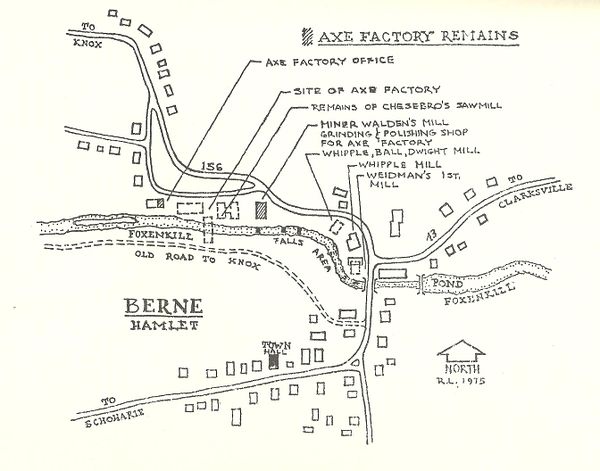Simmons Axe Factory
Daniel Simmons began life as a blacksmith and had a forge in the lower part of the city of Albany. Here he commenced making axes by hand for an occasional customer, using for the cutting edges German or blister steel, which was then supposed to be the only kind that could be successfully welded to iron. About 1825 it was found that by the use of refined borax as a flux, cast steel could be made to answer the purpose, and Mr. Simmons promptly took advantage of the discovery, being one of the first to put it to practical use. His axes soon became favorably known, and the demand for them was so increased that greater facilities for production became necessary. Accordingly in 1826, he removed to Berne, Albany County, where he secured a small water power, erected rude buildings, and put up trip hammers and other machinery.[1]
The following is from an article by Robert Lambert in Our Heritage:

1975 map by Robert Lambert, from Our Heritage
Simmons Axe Factory was the most extensive business ever conducted in Berne. The establishment of the factory began in 1825 and had a profound impact on the Town for the next few decades. Daniel Simmons had developed a design and welding process to make axes from cast steel which proved to be superior to all others. The capital for his enterprise was furnished by the likes of Jacob Settle, Malachi Whipple, and other early settlers.
The first building was erected on the north side of the creek in the rear of the house of John Steiner. A second building was extended across the creek as were a third and fourth building. The first building probably contained a trip hammer and a number of forges for shaping the axe blades. The second building was known as “the tempering shop.” The third building was about 100 feet long and also contained a trip hammer along with forges. The fourth and final structure, Miner Walden’s old Berne Carding and Fulling Mills, was used a grinding, polishing and painting shop.
In total, the factory ran twenty-one forges. Probably all these forges ran by charcoal which als0 employed many people in the making of it. In its prime, 200 men were employed and shipped about 600 axes and other edge tools per day. These axes were shipped as far as Asia and Africa.
However, the expense of transporting the axes to Albany over twenty miles of rough roads soon began to take its toll on the firm. The business ended in 1833, leaving many people penniless and unemployed. Simmons declared bankruptcy and moved to Cohoes.
The office portion of the Axe Factory still exists today at the end of Maynard Porter’s barn [1979]. The fourth building also remains, and has been used as a furniture factory, a Methodist meeting house, a grist mill and storage area. The building might serve as a memorial to a once flourishing business which did have a great impact on the Town of Berne.
Additional Information
Born in 1825, Horace B. Silliman was the only one of six children to survive to adulthood. He was educated at The Albany Academy, Albany, New York, and graduated from Union College, in Schenectady, New York in 1846, as a member of Phi Beta Kappa Society. Later, Silliman received honorary degrees from Union College and Hamilton College. Hamilton College, at one time, offered him its presidency, but he declined.
Following graduation from Union College, Horace became a druggist, opening a shop on Remsen Street in Cohoes. His interest in business was shared by his father whose local business ventures included the Simmons Axe Factory and Rathbone & Silliman, makers of iron furnaces.
It is only a comparatively few years since the manufacture of axes and other edged tools was an important industry. Daniel Simmons was the pioneer in this business, beginning it about sixty years ago; he had been a black- smith in Albany, where he made a few axes by crude methods. When the discovery was made in 1825 that cast steel could be used for such purposes with refined borax as a flux he promptly adopted the dis- covery in making axes and soon acquired an extended reputation. In 1826 he removed to Berne, Albany county, obtained water power and erected a small plant, with trip hammers and other machinery. When these facilities became inadequate he removed to Cohoes, where he founded the early establishment that became known throughout the world for the excellence of its product.
Sources
- ↑ THE HISTORY OF COHOES, NEW YORK, FROM ITS EARLIEST SETTLEMENT TO THE PRESENT TIME. Published in Albany, NY by Joel Munsell, 1877